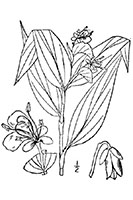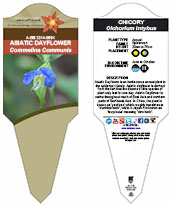

| Plant Name | Asiatic Dayflower | |
| Scientific Name | Commelina Communis | |
| Family | Spiderwort | |
| Plant Type | Annual | |
| Start of Blooming Season | June | |
| End of Blooming Season | October |

| Soil Conditions | |
| Soil Moisture | |
| Sunlight | |
| Notes: |

Asiatic dayflower is a creeping perennial plant that grows 20cm to 75cm in length. The stems of Asiatic dayflower will develop roots when in contact with soil. The roots are fibrous and susceptible to frost. The flowers are bilateral, and blue in colour, approximately 15mm wide with three sepals and and one white petal. each flower has six stamens. The leaves of Asiatic dayflower are 8cm to 13cm long and lanceolate with rounded bases. Asiatic dayflower blooms from June to October in the Northern Hemisphere and each flower only lasts for one day. Seeds range in length from 2.5mm to 4.2mm but seeds as short as 2 mm can occur, while they are 2.2mm to 3mm in width. The surfaces are rugose pitted-reticulate and are densely covered with smaller farinose granules with sparse larger farinose granules.

| Plant Height | 20cm to 75cm |
| Habitat | Cultivated areas, Disturbed Soil |
| Leaves | Lanceolate |
| Leaf Margin | Entire |
| Leaf Venation | Parallel |
| Stems | Smooth stems |
| Flowering Season | June to October |
| Flower Type | Bilaterally Symmetrical |
| Flower Colour | Blue |
| Pollination | Bees |
| Flower Gender | Flowers are hermaphrodite and the plants are self-fertile |
| Fruit | Small seeds in a swollen capsule |
| USDA Zone | 7A (-15°C to -17°C) cold weather limit |

No known health risks have been associated with Asiatic dayflower. However ingestion of naturally occurring plants without proper identification is not recommended.

 |
-Click here- or on the thumbnail image to see an artist rendering, from The United States Department of Agriculture, of Asiatic dayflower (This image will open in a new browser tab) |

 |
-Click here- or on the thumbnail image to see a magnified view, from The United States Department of Agriculture, of the seeds created by the Asiatic dayflower for propagation. (This image will open in a new browser tab) |

Asiatic Dayflower can be referenced in certain current and historical texts under one other name: Asiatic Dayflower can be translated into the following select languages: |
|||||||||||||
| Arabic | Bulgarian | азиатски дневен цвят | Chinese (Sim) | 鸭跖草 | |||||||||
| Croatian | azijsko suncokretovo | Czech | asijské denní květiny | Danish | asiatisk dagblomst | ||||||||
| Dutch | Aziatische dagbloem | Esperanto | azia tago | Estonian | |||||||||
| Finnish | asiallinen päivänkukka | French | tournesol asiatique | German | asiatische Tagesblume | ||||||||
| Greek | ασιατικό ηλιοτρόπιο | Hebrew | אסיאתית | Hungarian | ázsiai napraforgó | ||||||||
| Italian | Japanese | 露草 | Korean | 아시아계 데이 플라워 | |||||||||
| Punjabi | ਏਸ਼ੀਆਈ ਦਿਨਮੁਖੀ | Lithuanian | asiatiška dienos gėlė | Norwegian | asiatisk dagblomstring | ||||||||
| Persian | آبیاری روزمره | Polish | Portuguese | ||||||||||
| Romanian | flori de zi asiatice | Russian | азиатский подсолнух | Slovak | asijský denný kvet | ||||||||
| Spanish | florecilla asiática | Swedish | asiatisk dagblomma | Tagalog | |||||||||
| Turkish | Ukrainian | азіатський денне квітка | Vietnamese | hoa ban ngày | |||||||||

| The information provided in this conservation assessment has been provided by the Natureserve Database in conjuction with various federal, provincial, state, county, district, regional, and municipal governments as well as public and private conservation authorities. Information in this section is accurate from the last time this article was updated. |
|
 |
Asiatic Dayflower has no conservation status as it is concidered an invaisive species in North America. |

 |

 |
The MIROFOSS database offers free printable garden tags for personal and non-profit use. These tags can be used to properly identify plant samples in a garden. Click on the tags shown on the the screen or -click here- to download a full size jpeg image for an asiatic dayflower identification tag; which can be printed on paper or used with a plastic laser printer. |
 |
What's this? What can I do with it? |

| Description | Dickinson, T.; Metsger, D.; Bull, J.; & Dickinson, R. (2004) ROM Field Guide to Wildflowers of Ontario, Royal Ontario Museum, Toronto:McClelland and Stewart Ltd. |
| Folklore | Hanelt, Peter; Büttner, R.; Mansfeld, Rudolf; Kilian, Ruth (2001), Mansfeld's Encyclopedia of Agricultural and Horticultural Crops, Springer, p. 2414, ISBN 3-540-41017-1 |
| Description | Ohwi, Jisaburo (1965), Flora of Japan (in English), Washington, D.C.: Smithsonian Institution, p. 271, ISBN 0-87474-708-2 |
| Description | Invasive Plants of Asian Origin Established in the United States and Their Natural Enemies, Volume 1, USDA Forest Service, retrieved 2018-12-10 |
| Image Rendering | USDA-NRCS PLANTS Database / USDA NRCS. Wetland flora: Field office illustrated guide to plant species. USDA Natural Resources Conservation Service. |
| Environment | National Audubon Society. Field Guide To Wildflowers (Eastern Region): Alfred A. Knopf. ISBN 0-375-40232-2 |
| Physical Identification | National Audubon Society. Field Guide To Wildflowers (Eastern Region): Alfred A. Knopf. ISBN 0-375-40232-2 |
| December 10, 2018 | The last time this page was updated |
| ©2021 MIROFOSS™ Foundation | |
 |